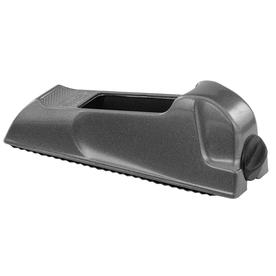LOL.
OK, the question is obviously about planes. I need to buy one because I don't own a single one. I know, shocking isn't it?
I guess some of you guys have a lot of them and probably quite costly ones. Stick told me he has over 200. Wow! For most of my projects I always try to cut the wood as close as possible to the finished sizes using my power saws and routers so until now I just haven't needed one. If something needed shaved a little bit I either just used a sanding block or made one of my chisels work, and its been rare that what I was making even needed it so I don't foresee a huge need in the future, either, based on the kinds of things I normally make. So if I only spent about $30 on just one, will this be a bad thing that will cause problems? Right now I simply need one to make some minor adjustments on the torsion box I am building. It will be shaving the edges of the Baltic plywood to remove high spots. I was just going to pick out an inexpensive but decent (not pure junk) LA block plane and use it for this, and also as a general purpose plane for anytime I need one again, until I discover that I want another one, if that happens.
In the last three months I have spent close to $2000 on woodworking items. My wife says this is only a hobby so I don't think she'll take well to me saying I need to drop another $100 on a plane when she sees models selling for less than $30. She's very supportive of what I do but that's not a conversation I want to have, especially since HER birthday is next week. Mine was in April. Can't justify it at all beyond basic need for just this project.
OK, the question is obviously about planes. I need to buy one because I don't own a single one. I know, shocking isn't it?
I guess some of you guys have a lot of them and probably quite costly ones. Stick told me he has over 200. Wow! For most of my projects I always try to cut the wood as close as possible to the finished sizes using my power saws and routers so until now I just haven't needed one. If something needed shaved a little bit I either just used a sanding block or made one of my chisels work, and its been rare that what I was making even needed it so I don't foresee a huge need in the future, either, based on the kinds of things I normally make. So if I only spent about $30 on just one, will this be a bad thing that will cause problems? Right now I simply need one to make some minor adjustments on the torsion box I am building. It will be shaving the edges of the Baltic plywood to remove high spots. I was just going to pick out an inexpensive but decent (not pure junk) LA block plane and use it for this, and also as a general purpose plane for anytime I need one again, until I discover that I want another one, if that happens.
In the last three months I have spent close to $2000 on woodworking items. My wife says this is only a hobby so I don't think she'll take well to me saying I need to drop another $100 on a plane when she sees models selling for less than $30. She's very supportive of what I do but that's not a conversation I want to have, especially since HER birthday is next week. Mine was in April. Can't justify it at all beyond basic need for just this project.





